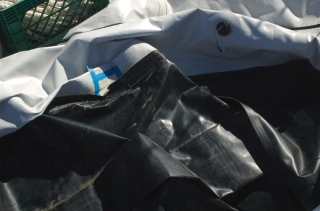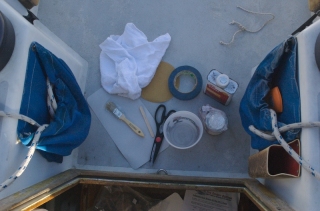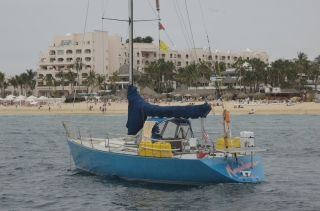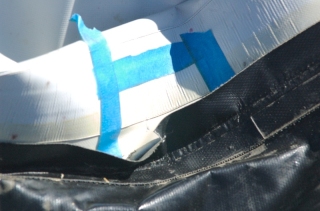Not everything about sailing is fun, although even the not-so-fun parts can be fun with the right mindset. That is what I kept telling myself through the whole process of repairing the dinghy. The poor little guy had been ferrying us sailors, first the four of us, and now myself, to and from the marina, onto beaches, through crashing surf for weeks and finally, one of his seams let loose.
It came as sort of an emergency. I awoke and was taking my morning survey of what happened while I was sleeping, and heard a loud hiss coming from the dinghy tied to the stern. Even in my groggy state, warning signals blared the full “A-OOOOOGH-A” and raised a general alarm. A 65-pound motor sits on the back of that dinghy, and that hissing noise meant that if I did not do something right away, there might be the opportunity to recover both the dinghy and that motor from the ocean floor . . . .

So, first things first: a quick moment of thought and planning. A big hole would make a “whoosh”–this was a “hiss” and a relatively small hole and most likely only on one side (the two tubes are separate). I would have at least 30 – 45 minutes to resolve this. The biggest problem is getting the 65-pound motor onto the boat–up to my chest when I stand in the dinghy. Was there some mechanical advantage I could use? For example, could I rig a sling and use the end of the boom or a masthead halyard to hoist it up?
I could do all of those things, if I had planned for it. Right now, I would simply have to lift it up and plop the motor on its side on the deck. The longer this process takes, the less air that would be in the dinghy, and the harder this whole thing is going to be. And, with that, the planning phase officially ended.
Cut away the tape that keeps the lifeline gates closed, and open the gate on the port side. Unhook the gas can and put all of the miscellaneous dinghy stuff onto the sailboat. Start the motor without the gas can attached–to burn all of the remaining gas in the engine. (It will be a few days, and gasoline sitting inside the motor will rot out the internals of a motor.) Unscrew the motor clamps, heave, and . . . before I knew it, the motor was already sitting on the deck. Another heave, and the dinghy was sitting on the foredeck, too–already folding awkwardly like a partially-deflated beach toy.
The repair process was not so bad. It took a day for the dinghy to dry out (and for me to scrape the creepy-crawlies off the bottom). It took another day or so for me to select the right dinghy repair kit from the local chandleries. It seems that there is really no in-between when it comes to these kits. There are the cheap “patches” that should actually be used for your partially-deflated beach toy, and then full-blown, serious dinghy repair kits with two-part glues, etc. I opted for the latter because I do not want to spend my time down here repairing dinghies. Do it once, do it right, and get on with your trip . . . .

I cleaned the surface of the dinghy to be repaired with acetone, cut the patch to the correct size, and mixed a portion of the two-part glue. Taped around the area for the patch, painted the surface, let dry for 5 minutes, applied the patch, press really hard for a few minutes, and then clean up the excess glue–while it is still wet. And, then wait . . . for 24 whole hours. All of the remaining glue got used to lovingly coat the seams that had started to pull open in places from the years of use.
I waited the full day, reversed the get-the-dinghy-out-of-the-water process, and was free, once again, to dinghy away from the sailboat–unfettered by the cares of the world (with the exception of that big wave threatening to splash you).







 This weekend, we are going on a little roadtrip, and I am going to take along a little reading.
This weekend, we are going on a little roadtrip, and I am going to take along a little reading.
